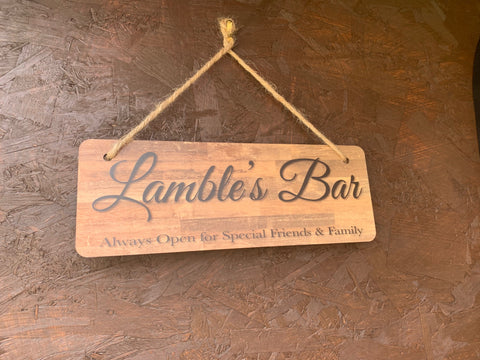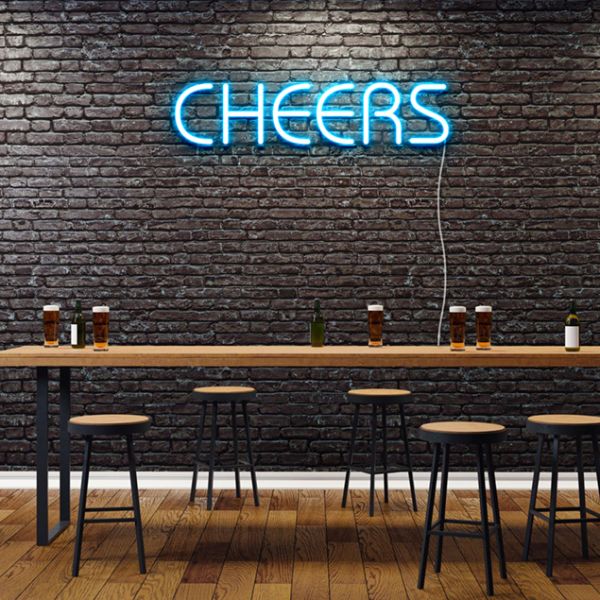Good News For Picking Gin Bar Signs
Good News For Picking Gin Bar Signs
Blog Article
How Do Bar Signs Differ In Terms Of Size?
There are various sizes of bar signs based on the purpose of their design, their location, and how they look. This article will explain how different sizes affect bar signs in terms of functionality and design. Large Signs
Purpose: To serve as a focal and attract attention.
Examples include: outdoor signage, branding and wall panels with features.
The placement is typically placed above entrances, walls or outside of the bar. This will draw in patrons.
Examples include large neon signs large vintage-style signs, or massive wall-type signs.
2. Medium Signs
Uses: Provide details or decorate the room without taking over.
Uses include menu boards, as well as directional signs and promotional displays.
Location: Ideally placed to be easily spotted but not overwhelming.
For example chalkboards of medium size with daily specials, or metal signs with the bar's logo.
3. Small Signs
The purpose is to provide specific information or to add subtle decorative elements.
Applications: Small, decorative pieces or labels.
Tables, shelves or in displays in which close-up viewing is desired.
For example: table number signs or small frame quotes.
Size Aspects
Visibility
Large Signs are made to draw attention of passers-by and establish the bar’s presence.
Medium Signs: Balances the need for visibility with space efficiency, delivering important information without overpowering the decor.
Small Signs are great for information or details that is close up. They can be placed on tables or at eye level to improve the experience of the patrons.
Proportion
To prevent overwhelming smaller areas the large sign should be in proportion to the size of the area. A great choice for big or open environments.
Medium Signs: These signs are ideal for various interior areas. They are able to be placed in various ways.
Small signs are perfect for adding detail and can be placed in tighter spaces.
Impact
Large Signs: Creates an impact and is a crucial branding component. Bar signs can be used to set a certain tone.
Medium Signs are able to strike a balance between visibility and decor that contributes to the overall ambience while conveying vital information.
Small Signs (Signs) are a great way to add detail and a sense of humour to a visual experience.
Practicality
Large Signs: These signs require large mounting solutions and are more expensive because of their dimensions.
Medium Signs are easy to install and reposition. They also provide flexibility with regard to design modifications.
Small signs are perfect for locations that are constantly changing like bars, which frequently change their menus or promotions.
Functionality
Large Signs: Mainly used to draw attention and increase visibility.
Medium signs are useful as well as decorative. They provide vital information and enhance the aesthetics.
Small Signs can be used to communicate information in a clear manner. They are also utilized to enhance the look of your thematic.
Selecting the appropriate size for bar signs depends on their intended function and the layout of the space and the impact they want to have on the patrons. This ensures that the importance of the sign to the atmosphere of the bar and operational requirements. View the top bar signs for more info including pub sign design ideas, pub signs made, personalised hanging bar sign, large pub sign, pub sign design ideas, hanging tavern sign, personalised outdoor bar signs, to the pub sign, bar signs for home, signs for garden bar and more.
What's The Difference Between Mounting And Installing Bar Signs?
The kind of bar sign, its dimensions, its weight, their place of installation, and their function will determine the way it is mounted and installed. Let's take an deep look at the various mounting and installations methods for bar signs: 1. Wall-Mounted Signs
Fixed directly to walls.
Methods:
Screws and anchors: This is common for heavier signs like metal or wood.
Adhesive Strips: Suitable for signs that are lighter (foam board, acrylic) and temporary installations.
Brackets are used to hold signs visible from walls for greater visibility.
Uses: Indoor decor, menu boards, directional signs.
Advantages: Adjustable with a secure and clear display.
Negatives: May cause damage to walls, and are difficult to reposition.
2. Hanging Signs
Characteristics Suspended overhangs or ceilings.
Methods:
Chains are durable and adjustable great for signs with heavy weights.
Cables: A sleeker look that is often employed in contemporary designs.
Rods: Provide a rigid support structure.
Uses: Ceiling decor, directional signs, overhead promotional signs.
Vertical space is highly visible and the decorative options are limitless.
Negatives : Needs to be secured by ceiling anchors. It can sway if not properly stabilized.
3. Freestanding Signs
The main characteristic is that it is not attached to any structure, but supported by a stand or a base.
Methods:
A-Frames: Portable and foldable frequently employed for advertising on sidewalks.
Pedestal Stands: Stable base, ideal for indoor use.
Panel and post: Typical for larger permanent signs.
Uses: Outdoor advertising, indoor directional signs, promotional displays.
The lightweight and flexible design makes it easy to alter.
It is often bulky and requires an area for floor.
4. Window Signs
Characteristics Attached directly onto windows.
Methods:
Suction cups are perfect for signs that are light in nature, since they are easy to remove and put in.
Adhesive Film: This material is directly applied to the glass and is used to create graphics or decals.
Static Clings: They're permanent but not permanent. They can be reused and they are easy to remove or install.
Applications: Promotional messages, and branding.
Advantages: Maximizes space in the window and is highly visible outside.
Window size limitations and light levels can affect performance.
5. Signs with Backlights and Edge-Lits
Characteristics include: Lighting within the structure of the sign.
Methods:
Wall Mounting with Electric Connections: requires a secure connection as well as electrical connections.
Suspended with Power Cables Suspended with Power Cables: Combines hanging and integrated lighting.
Uses: High-visibility branding menu boards as well as decorative elements.
Benefits: Better visibility and attractive lighting.
Installation is more complicated and requires electrical skills.
6. Temporary and portable signs
Features: Simple to install and remove.
Methods:
Pop-Up Stands are lightweight and compact.
Banner Stands: Roll-up or retractable designs.
Uses: Events, promotions, seasonal decor.
Quick and easy setup.
Advantages : less durable and may not be stable.
7. Magnetic Signs
Magnetic force used to secure.
Methods:
Magnetic Strips: Applied to the back of the sign.
Magnetic Boards: Signs that stick to metal surfaces.
Uses: Changeable menu boards, temporary notices.
Benefits The benefits are that no permanent fixtures are needed, and the item is simple to change.
Advantages: Restricted to areas with magnetic properties, they are less secure.
8. Projection Signs
Features: Project images or texts using light.
Methods:
Mounted Projectors: Securely mounted on ceilings or walls.
Portable Projectors can be placed on stands and other surfaces.
Uses : Dynamic displays for promotions, events and other promotions.
Advantages: It is easy to change the content No physical sign required.
Disadvantages
Considerations for Mounting and Installation
Weight and Size
Heavy Signs (Heavyweight) These signs require more durable mounting solutions such as bolts and screws.
Light Signs - You could employ less complicated techniques like suction cups or strips of adhesive.
Durability
Permanent Signs: Use an extra secure and long-lasting mounting method.
Temporary signage: Select methods that make it easy to move and relocate the sign.
Location
Indoor: Greater flexibility with materials and methods, less concern for weather resistance.
Outdoor: requires weather-resistant materials and a secure mounting order to withstand the elements.
Aesthetics
Concealed Mounting: Gives you a clean look by hiding hardware.
Decor Hardware: Enhances appearance of the sign.
Accessibility
Easy Access for Changes Essential for signs that require frequent updates, such as menu boards.
Security: Ensure signs can't be easily tampered or stolen.
Bar owners need to take into consideration these aspects when choosing the most suitable mounting and installation method that suits their needs. This will make sure that their signage are secure, visible and meet their aesthetic and functional requirements. Read the best bar hanging sign for website info including design a pub sign, bar wall signs, garden bar signs, small pub signs, personalised home pub sign, pub signs, design a pub sign, large pub sign, home pub signs, hanging home bar signs and more.
What Distinguishes Bar Signs From One Another In Terms Of Branding?
Bar signs have a vital function in branding. They convey the character of a place, its style and its brand's identity. The following are the differences between bar signs in regards to branding:1. Logos and Brand Identity
Logo Integration: Incorporating the logo of the bar prominently on signage creates brand recognition and helps establish the bar's brand identity.
Consistent branding: Signs need to be in line with other branding materials such as menus. coasters as well as social media profiles, and many more.
2. Visual Style & Design
Thematic Design Signs reflect the theme and atmosphere of the bar, regardless of whether it is a cozy bar, sleek lounge or vibrant nightclub.
Custom Graphics - Custom graphics, images and typography can help distinguish brands and draw patrons the attention of customers.
3. Color Scheme
Branded colors: Make use of the bar's logo colors to create a consistent visual identity. This will reinforce brand recognition.
Contrast and legibility: Colors are selected not just to ensure consistency in branding, but also for readability and visibility in various lighting conditions.
4. Message and Tone
The signs communicate the personality of the bar through the messages they convey. They could be fun and casual, or elegant and sophisticated.
Taglines and Slogans: Utilizing appealing slogans and taglines to reinforce a brand can leave a lasting effect on the customers.
5. Visibility and placement
Signs strategically placed for maximum effectiveness and visibility.
Size and scale Signs that are larger and bigger draw attention and make a dramatic statement, whereas smaller signs can provide subtle branding clues in less intimate settings.
6. Specialty Signage
Signage: Customized signage like neon signs or chalkboard menus can add to the character of a bar and reinforce the brand's image.
Interactive Elements: Signs that have interactive elements like QR codes or digital menus that engage customers, improve their experience, and increase brand recognition.
7. Brand Storytelling
Signs that incorporate historical elements, such as the location of the establishment or its founder, can make a connection and a sense of authenticity with customers.
Unique Selling Points : Signage that emphasizes specials, signature drinks, or distinctive characteristics will draw patrons in and strengthen the bar's unique selling point.
8. Branding for seasonal promotions
Holiday Themes. Decor and themed signage reflect a bar's festive mood and create the perfect experience for the patrons.
Advertising that promotes special occasions like happy hour or special offers can increase sales.
9. Customer Engagement
User-Generated Material: By encouraging patrons to use social media to upload photos of your signage that you have installed, you can expand the reach of your brand and create a sense community at your bar.
Interactive Signage. Signs inviting patrons to take part (such as chalkboard walls or photo booths) provide a memorable experience and boost the brand's reputation.
10. Digital Branding
Digital Signage: Interactive screens LED screens, digital menus are excellent for branding because they can be updated in real-time and also allow animations.
Online Social media handles that are displayed on signs promote online interaction, linking patrons with the bar's digital presence and increasing brand awareness.
Signage can be utilized as an opportunity to promote the bar, attracting patrons and differentiating it in an increasingly competitive market. This will ultimately foster loyalty and boost business growth. See the most popular bar sign hanging blog for site tips including outdoor personalised bar sign, signs for garden bar, large personalised bar signs, personalised home pub sign, modern pub sign, large personalised bar signs, pub signs made, staying inn sign, large pub sign, small pub signs and more.